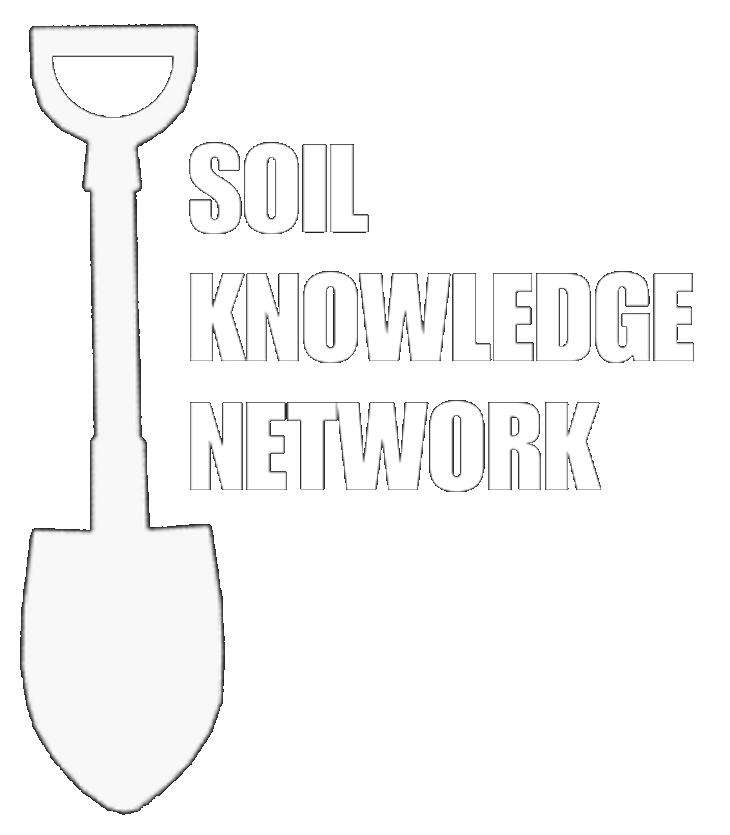Groundcover consists of live or dead plant matter, litter and woody detritus, rocks and gravel, and cryptogam crusts, on or near the ground surface. Percentage groundcover is the extent to which the soil surface is covered by this material.
Groundcover management is a key element of land management and is critical in dry times and during drought.
Groundcover is important in cropping, grazing, conservation and all land management as it:
• protects the soil from water and wind erosion and the breakdown of the soil surface structure;
• produces feed for grazing animals;
• increases infiltration of water into the soil;
• produces organic matter (soil carbon);
• stops seeds, nutrients and organic matter from washing or blowing away; and
• protects seeds and seedlings.
Groundcover also plays a significant role in increasing the turnover of plant nutrients and promoting soil biological activity.
The Soil Conservation Service of NSW determined the relationship between groundcover levels and rainfall runoff and consequent soil loss. For open, sloping grazing lands in the east of NSW a minimum groundcover level of around 70% is required to minimise water erosion (Lang 1979). See Figure 1.
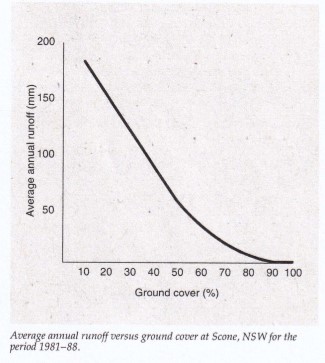
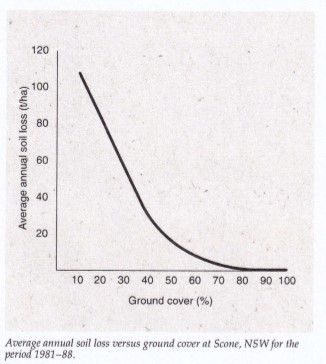
Figure 1. Groundcover and Annual Average Runoff and Soil Loss at Scone, NSW (1981-88). P. Walker Pers. comm.
Even higher levels are required for steep coastal land and land especially prone to erosion. For flatter grazing lands on the western plains this requirement gradually reduces to about 40%. For western rangelands, where groundcover is not continuous even in good seasons, a
groundcover weight of about 200-300 kg/ha has been proposed as the stage at which stock should be removed to protect soil and relieve pressure on native perennial species.
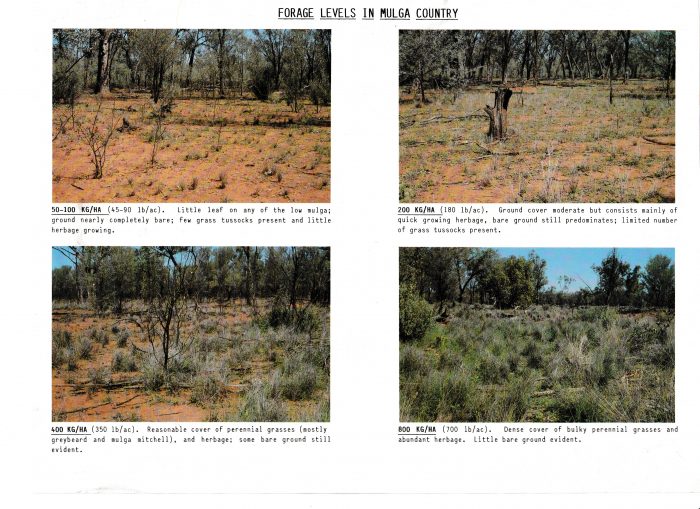
However, groundcover can be reduced below these critical levels by the effects of grazing, cultivation, fire, land clearing, logging, herbicides, pollution, compaction or salinity.
Ninety percent of soil loss at six Soil Conservation Service Research Centres in NSW over a period of 30 years resulted from only 10% of runoff events, and these events were almost entirely confined to periods when groundcover was below 50% (Lang and McCaffrey, 1984). So although erosion is very episodic, the consequences remain and affect productivity and land management for a long time afterwards.
In NSW, most erosive rain falls during the summer months, so it is especially important to maintain high levels of groundcover during summer.
Wind erosion is an additional hazard, particularly in low rainfall areas with sandy soils, in bare fallow or grazing land. It is best abated by groundcover of at least 50% (Leys 2003).
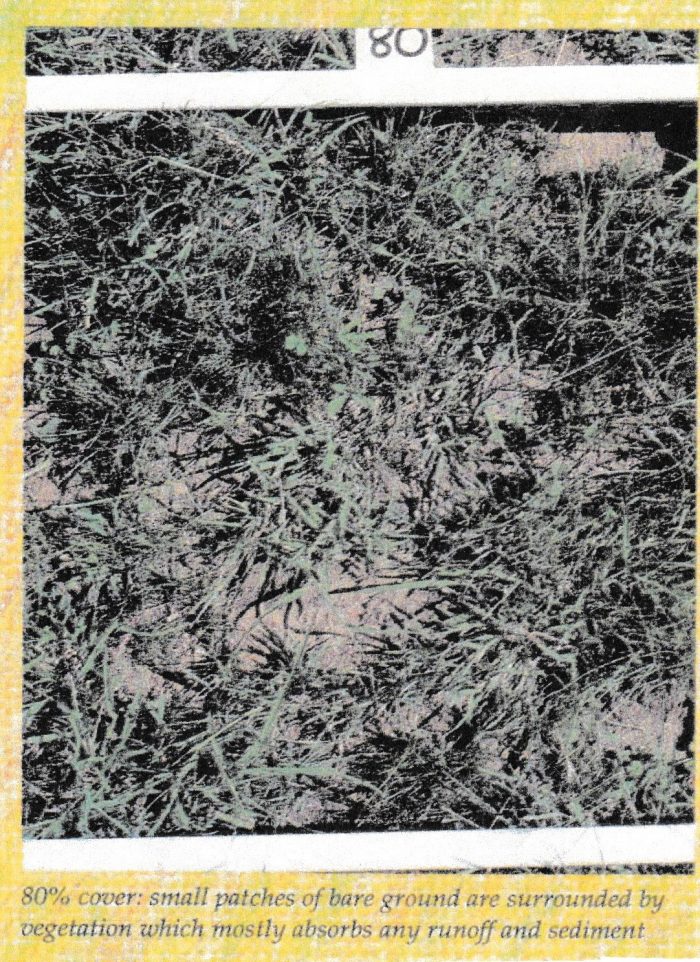

Figure 3. Examples of 80% and 65% ground cover in pasture. From Lang (1995).
Groundcover is especially important in the management of low rainfall areas with native pastures where traditional soil conservation measures are not viable, for cropping lands during fallow periods, for sloping grazing lands, and more generally in times of drought.
Most damage to the groundcover and the soil occurs following excessive grazing for long periods, where the basal cover of grass butts declines, or when perennial plants are absent. Minimal replenishment of soil nutrients follows because little or no plant material remains to decompose. Raindrop impact and crust formation increase, and with time these soil surfaces become biologically inactive and bare areas expand. Infiltration of rainwater into the soil is reduced. This, together with a bare surface which is highly susceptible to abrasion by soil particles carried by the wind, is inimical to the establishment of new plants. As these bare areas expand and join up, runoff and soil erosion rates increase markedly.
On grazing lands, groundcover should consist of a range of desirable plants for optimum productivity in all seasons, containing perennial species and others that can respond to rainfall whenever it may fall.
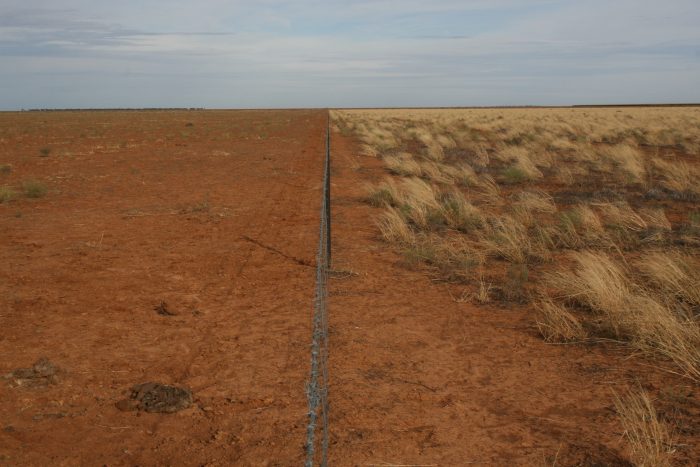
On cropping lands, groundcover is likely to be a single species crop and/or stubble. Cover levels for adequate protection of cropping country are shown in the table below. Higher rates are required on steeper country not protected by contour banks, or for crops with fine stubble.
| Erosion | Soil Type | Minimum Amount of Standing Wheat Stubble Required to Protect Soil from Erosion (t/ha) |
| Water | Sand | 0.5 |
| Clay loam | 0.8 | |
| Clay | 1.0 | |
| Wind | Sand | 1.0 |
| Clay loam | 0.5* | |
| Granulated clay | 0.8* |
Marston 1978, Leys 2003).
However, in the southern cropping areas of NSW 3-4 t/ha of stubble is considered necessary for effective erosion control (I. Packer, pers. com.)
It follows that bare fallows should be avoided.
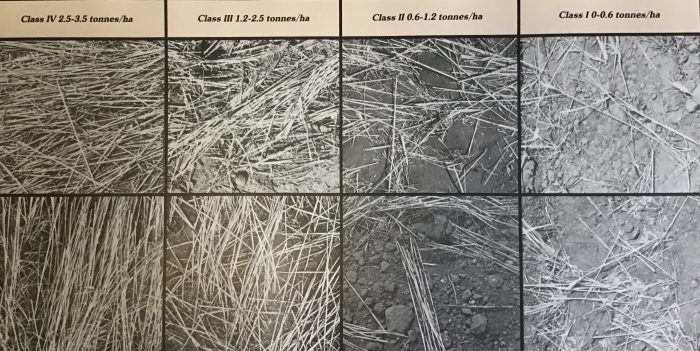
In horticultural industries like orchards, vineyards and blueberries, inter-row groundcover can be used to prevent soil erosion, with mowing to reduce bulk and fire hazard when necessary. The same cover levels apply as for grazing.
In non-rural development and construction situations, including urban subdivisions, groundcover needs to be retained wherever possible during the construction phase, along with soil conservation measures to trap runoff and sediment. In the operational phase, permanent groundcover can be used to protect the soil surface in areas not occupied by structures and access ways.
Groundcover can be a surrogate for land conditon and can be used to assess land condition and land management across similar land and soil types.
A simple and convenient way to estimate groundcover percentage is by step pointing.
This is done by stepping across a paddock in a straight line for 100 paces; at each step recording what is directly under the front of the boot toe – whether it is groundcover of any sort or just bare ground; and then counting up the totals and calculating the percentages.
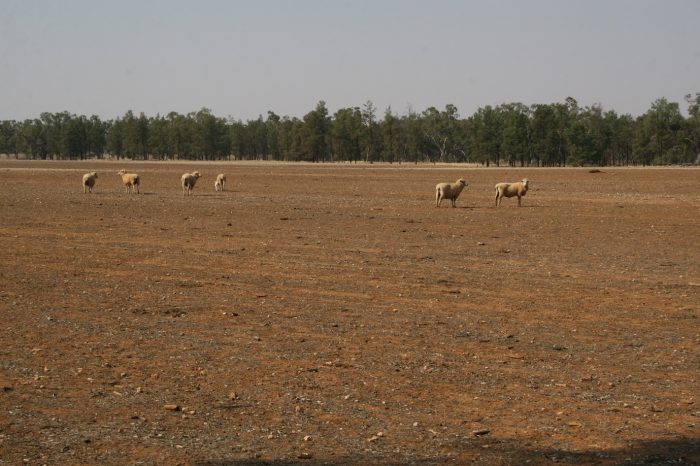
Groundcover monitoring by satellite is now well developed and has been used for regional and long-term assessment. There are several remote sensing tools which can be used to assess groundcover, including from eo-data.csiro.au and map.geo-rapp.org/#australia or VegMachine.net, which was developed in Queensland but is more broadly applicable. Road transects can also be used to assess groundcover and are being used in the Central Tablelands of NSW. These can be useful extension tools for land management advice.

Soil Knowledge Network Position
The Soil Knowledge Network recognises that:
•Groundcover is essential for the protection of the soil surface from the impacts of rainfall, runoff and wind, which would otherwise cause erosion of soil, damage to surface soil structure, and sedimentation off-site.
• Groundcover also plays significant roles in increasing water infiltration into soil, increasing accumulation of soil organic matter and carbon stocks, the turnover of plant nutrients, and soil biological activity.
• Long term maintenance of groundcover is a leading indicator of good land
stewardship.
• By manipulating grazing rates, land managers should aim to maintain groundcover levels at 70% or more of the soil surface for sloping grazing lands in eastern and central NSW, at 80% for steeper coastal lands, and at least 40% for the western plains and rangelands.
• On broad-acre cropping lands, crop stubble should be retained between crops, preferably as standing stubble. To minimise water erosion standing stubble should be at least 0.5 t/ha on sandy soils and 1 t/ha for clays. To minimise wind erosion, it should be at least 1 t/ha on sandy soils and 0.5 t/ha on clay loam. As a guide, flattened stubble should cover at least 50% of the soil surface.
• In horticultural lands, groundcover should be established and retained between rows and, when necessary, managed by mowing.
• In industrial situations, groundcover can be used during construction phases for temporary soil protection, and as a permanent protective cover for open areas in the operational phase. For solar farms, the areas under and adjacent to solar panels should have permanent groundcover, which should be maintained at a level of at least 80% (see separate Solar Farm Position Statement).
The Soil Knowledge Network strongly supports groundcover monitoring for sustainable land management, at both paddock and regional scales.
References
Lang, R. D. (1979). The effect of groundcover on surface runoff from experimental plots. J. Soil Cons. NSW, 35 (2), 108-114.
Lang, R. D. (1995). The Cover Equation – How Much is Enough? Department of Land and Water Conservation, Gunnedah.
Lang, R. D. and McCaffrey, L. A. H. (1984). Ground cover- its effects on soil loss from grazed plots, Gunnedah. J. Soil Cons. NSW, 40 (1), 56-61. Leys, J. F. and Semple, W. S. (1984). Estimating the weight of crop residues for wind erosion control. Western Area Technical Bulletin No. 24, Soil Conservation Service of NSW.
Leys, J. F. (2003). Wind Erosion. NSW Department of Infrastructure, Planning and Natural Resources, Parramatta. 7pp.
Marston, D. (1978). Stubble retention in practice. J. Soil Cons. NSW, 34 (4), 228-229.
Rosewell, C. and Marston, D. (1978). The erosion process as it occurs within cropping systems. J. Soil Cons. NSW, 34 (4), 186-193.
Walker, P. J. (1992). Managing for Drought. Technical Paper No. 1, NSW Department of Conservation and Land Management.
